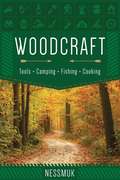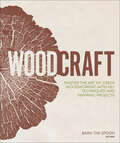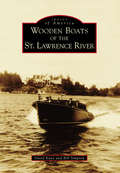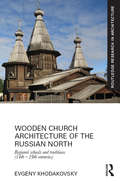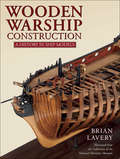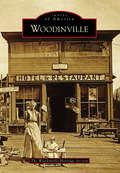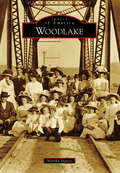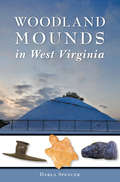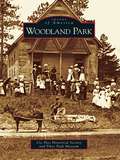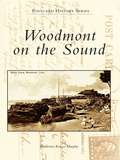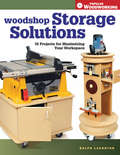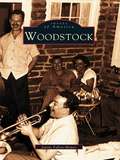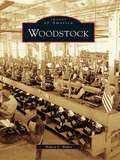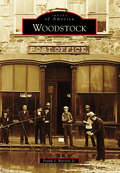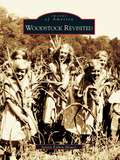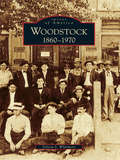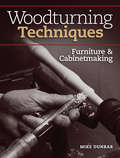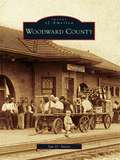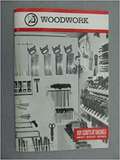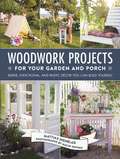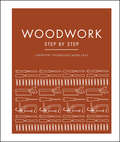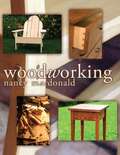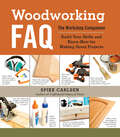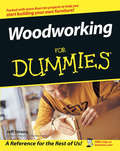- Table View
- List View
Woodcraft
by NessmukLegendary canoeing guide, conservationist in the 1800s, and one of the first proponents of the hyper popular "ultra-light” camping style, George Washington "Nessmuk” Sears was a true American mountain man. Using a 9-foot-long, 10 and a half pound canoe he successfully completed a 266-mile journey through the central Adirondacks. His classic treatise on American camping, Woodcraft , is definitive proof that he was the most capable and intelligent woodsman of his time.First published in 1884, and continuously in print ever since then, this is the ultimate book for hikers, campers, fishers, canoers, and anyone else who feels the call of the wild. With information on what to bring, how to build fires, how to fish with and without flies, and how to cook, this book is still totally relevant in our modern society. For anyone with even a passing interest in getting closer to nature this is required reading. The forerunner of the ultra-light camping movement and the precursor to all other books on camping and traveling through the wilderness, Woodcraft belongs on the bookshelf of every aspiring mountain person.Skyhorse Publishing is proud to publish a broad range of books for fishermen. Our books for anglers include titles that focus on fly fishing, bait fishing, fly-casting, spin casting, deep sea fishing, and surf fishing. Our books offer both practical advice on tackle, techniques, knots, and more, as well as lyrical prose on fishing for bass, trout, salmon, crappie, baitfish, catfish, and more. While not every title we publish becomes a New York Times bestseller or a national bestseller, we are committed to publishing books on subjects that are sometimes overlooked by other publishers and to authors whose work might not otherwise find a home.
Woodcraft: Master the Art of Green Woodworking with Key Techniques and Inspiring Projects
by Barn the SpoonLooking for a simpler, more natural way of working with wood? Create beautiful wooden objects from fresh green wood by becoming skilled in the crafts of whittling, ax-based furniture making, turning, and weaving.With green woodworking there's no need for costly materials and machinery. All you need to begin crafting is a log, an ax, and a hand knife.Starting with selecting and splitting your very first log, let Woodcraft show you all the techniques of green woodworking and guide you step by step through a series of rewarding projects.Learn to carve your own spoons, bowls, shrink boxes, and other objects; construct simple pieces of furniture, such as stools and side tables; turn wood on a pole lathe; and weave with willow rods and birch bark.Woodcraft brings up-to-date a newly resurgent folk craft and makes it truly accessible to all--no workshop required. So, what are you waiting for? Get in touch with nature and find harmony working with your hands.
Wooden Boats of the St. Lawrence River (Images of America)
by Bill Simpson David KunzThe Thousand Islands’ very name conjures up images of great natural beauty and nautical wonders. They are forested islands replete with storybook stone castles. Exquisite mahogany runabouts can be seen speeding across the placid surface of the mighty St. Lawrence. Names like Boldt, Bourne, Emery, Lyon, and Pullman are embedded in the Golden Age of the area, and it all comes to life in this pictorial history of the river. Images of America: Wooden Boats of the St. Lawrence River tells the story of the rich and powerful men who constructed castles and built classic wooden boats in the Thousand Islands. At the center of the story loom David and Charlie Lyon.
Wooden Church Architecture of the Russian North: Regional Schools and Traditions (14th - 19th centuries) (Routledge Research in Architecture)
by Evgeny KhodakovskyThe book presents a broad panoramic overview of church architecture in the Russian North between the fourteenth and nineteenth centuries. While it is inevitably overshadowed by the imperial splendour of the country’s capital cities, this unique phenomenon is regarded as the most distinctive national expression of traditional Russian artistic culture and at the same time as a significant part of humanity’s worldwide architectural heritage. The chief intention of the book is to present the regionally specific features of the wooden churches of the Russian North, which vary from area to area for local natural or historical reasons. This approach touches upon the very important questions of the typology and classification of the multiplicity of architectural forms. The "regional view" entails giving clear definitions of the ambiguous terms "architectural school" and "tradition", explaining the origins and shaping impulses for the different regional clusters of objects. Structurally the book presents a history of the development of wooden church architecture in the Russian North and then follows the key points of the mediaeval Russian expansion along the waterways from Novgorod into the North – he Svir’ River, Lake Onego, the town of Kargopol’ and the River Onega, the White Sea, the Rivers Dvina, Pinega and Mezen’ – those areas that still retain the most splendid pieces of Russian regional wooden church architecture. The study is based on field research and provides an up-to-date, multi-faceted view of Russian wooden architecture.
Wooden Warship Construction: A History in Ship Models
by Brian LaveryThe National Maritime Museum in Greenwich houses the largest collection of scale ship models in the world, many of which are official, contemporary artifacts made by the craftsmen of the navy or the shipbuilders themselves, and ranging from the mid seventeenth century to the present day. As such they represent a three-dimensional archive of unique importance and authority. Treated as historical evidence, they offer more detail than even the best plans, and demonstrate exactly what the ships looked like in a way that even the finest marine painter could not achieve. This book takes a selection of the best models to both describe and demonstrate the development of warship construction in all its complexity from the beginning of the 18th century to the end of wooden shipbuilding. For this purpose it reproduces a large number of model photos, all in full color, and including many close-up and detail views. These are captioned in depth, but many are also annotated to focus attention on interesting or unusual features, which can be shown far more clearly than described. Although pictorial in emphasis, the book weaves the pictures into an authoritative text, producing an unusual and attractive form of technical history.
Woodinville
by The Woodinville Heritage SocietyThe community of Woodinville, located northeast of Seattle across Lake Washington, traces its origins to Ira and Susan Woodin, who arrived in 1871. The young family rowed their boat from Seattle across the lake, then up a wide, sluggish stream called Squak Slough (later Sammamish River) to settle on 160 forested acres. Joined by more settlers within 10 years, the small settlement was first defined by logging camps and sawmills. The Seattle, Lake Shore & Eastern Railroad came to town in 1887, tying the community to the neighboring settlements and bringing more homesteaders. After the timber was removed from the river valley, large-scale farming and dairying took over the fertile area for the next 60 years, culminating in a viticulture industry that has given the once-bucolic valley a national reputation for wineries and tasting rooms.
Woodlake
by Marsha IngraoKnown as the area "within the magic circle," the Western town of Woodlake, along with its surrounding valley, is rich in both natural resources and hardworking citizens who are proud of their heritage. Most Tulare County towns sprang up along the Southern Pacific Railroad. Woodlake, designed as a tourist town, drew together farming communities, consisting of people too busy raising fruit and cattle to create a town. Starting with Thomas Henry Davis in 1853, settlers established farms and ranches, which attracted Los Angeles millionaire Gilbert Stevenson when he arrived in 1907. Approved by the Tulare County Board of Supervisors on October 3, 1911, the world-class tourist town named Woodlake grew from Stevenson's imagination into reality. Led by the strong sales personality of its founder, Woodlake grew quickly, yet it remained a Western town, retaining reference points to the early communities that visitors would not find on signs. Visitors to Woodlake today will find Woodlakeans still doing what attracted Gilbert Stevenson: raising cattle and growing citrus within protection of the Sierra Nevada and foothills.
Woodland Mounds in West Virginia (American Heritage)
by Darla SpencerThe first Europeans to arrive in the Ohio Valley were intrigued and puzzled by the many conical earthen mounds they encountered there. They created wild theories about who the mysterious "Moundbuilders" might be. It was not until the 1880s that Smithsonian Institution investigations revealed that the Moundbuilders were the ancestors of living Native Americans. More than four hundred mounds have been recorded in West Virginia, including the Grave Creek Mound in Marshall County, the largest conical mound in North America. Join archaeologist Darla Spencer and learn about the Grave Creek Mound and fifteen additional Adena mounds from the fascinating Woodland period in West Virginia.
Woodland Park
by Pikes Peak Museum Ute Pass Historical SocietyWoodland Park, at an altitude of nearly 8,500 feet, is located 18 miles west of Colorado Springs along the north slope of Pikes Peak in eastern Teller County. Much of the history of the West passed through this area on the old Ute Trail--now Highway 24--as hunters, trappers, cowboys, Native Americans, settlers, miners, railroaders, ranchers, and tourists discovered an abundance of natural beauty and varied business opportunities through the years. Woodland Park is now home to about 8,000 year-round residents, many of whom treasure not only the spectacular scenery but also the rich past of the town. This evocative tour through that past shares vintage photographs collected by the Ute Pass Historical Society.
Woodmont on the Sound (Postcard History Series)
by Katherine Krauss MurphyWoodmont on the Sound inhabits a small corner of the world: one square mile with a mile and a half of shoreline on Long Island Sound. It is a borough within the city of Milford, and at the beginning of the 20th century it became a popular summer resort, as trolleys ran through the area from New Haven to Bridgeport. Stately wooden hotels, inns, and cottages welcomed guests for days, weeks, or the entire summer season. Woodmont was a destination for those seeking sun, swimming, boating, and fishing during the hot summer months. Before electricity, telephones, and automobiles, postcards were a fun and vital communication between Woodmont residents and the outside world.
Woodshop Storage Solutions: 16 Projects for Maximizing Your Workspace
by Ralph LaughtonProjects for reinventing your woodshopAre you constantly looking for better and more efficient ways of storing and using your tools? By the time you've collected your tools, gathered materials and started working on your woodworking projects, space can be at a premium. This book contains 16 ingenious projects that will make your woodshop totally efficient, extremely flexible and very safe.Projects include:Chisel rackSandpaper pressSmall-items chestRouter-cutters-storage cabinetDrill press cabinetTool tote and stoolSmall offcuts storage trolleyWall-hung tool cabinetDowndraft tableClamp rackMobile table saw standOutfeed tableFreestanding cabinetRouter trolleyComputer stationRouter table
Woodstock
by Janine Fallon-MowerOrganized as a town in 1787, Woodstock has since been defined by a triangle of three distinct and powerful influences, weaving an uneasy balance: the legacies of the arts and crafts colony established at Byrdcliffe, the 1969 Woodstock Music Festival held in Bethel, and the people who live and work and raise families in the community. Woodstock provides a fascinating look at the community from the 1890s through the 1980s. With more than two hundred stunning images, it revisits the days when the center was simply a sleepy grass-covered village square. Shown are many buildings that no longer exist: the boarding homes, the icehouses, the bowling alley. The story captures the community as it passes through the arts-colony and music-festival years to become the busy tourist town it is today.
Woodstock
by Nancy L. BakerWelcome to Woodstock, a picturesque Victorian town built around a town square. Originally called Centerville, Woodstock was selected as the county seat of McHenry County in 1843 because of its location almost exactly in the center of the county. Over the decades, Woodstock has welcomed those who came to conduct personal, legal, and civic business on the Woodstock square, to work in Woodstock's typewriter, die casting, and other factories, to attend theatrical productions at the opera house and band concerts in the park. Woodstock residents and those from surrounding towns gathered in Woodstock to see McHenry County's service men and women off to war, to welcome them home and celebrate their safe return, to mourn those who gave their lives, and to honor all who served.
Woodstock (Images of America)
by Frank J. Jr.Set in outstanding natural beauty, many Vermont communities have a unique sense of history and place, and Woodstock has long been considered among the most vibrant and beautiful of them all. Nestled within the eastern foothills of the Green Mountains and the Ottauquechee River valley, from the time of its founding in 1761, the story of Woodstock has been a tapestry rich with culture, architecture, and events. Early in the town’s development, Woodstock was designated by Vermont as the seat of government for Windsor County, and in turn, this brought an influx of lawyers and other professionals together with business and real estate entrepreneurs. The joining of several early turnpikes in Woodstock meant more travelers through town. In years after 1875, when the Woodstock Railway opened, the town became an even greater hub for tourists and those on business. By the early 20th century, Woodstock with its great scenic beauty was recognized as a premier destination for year-round recreation.
Woodstock 1969: The Lasting Impact of the Counterculture
by Jason Lauré Ettagale BlauerAs the fiftieth anniversary of the Woodstock festival nears, Woodstock 1969 stands out for its singular voice. Photojournalist Jason Lauré followed his unerring instinct for being in the right place at the crucial moment. He and coauthor Ettagale Blauer trace the historic events that preceded the festival and then envelop the reader with photographs of the headliner rock stars that performed during the landmark three-day concert including the Who, Janis Joplin, Grace Slick of Jefferson Airplane, and Santana. <p><p> Threading his way back and forth from the stage, through a sea of happy audience members, Jason Lauré photographed the communal life that was an essential part of the phenomenon that was Woodstock. Never intrusive, yet working close-up, he managed to capture these innocent moments in the pond and in the woods with the same compassion and intimacy he brought to his coverage of all the crucial events of the era. After Woodstock, he photographed such legends as Jimi Hendrix, Tina Turner, and Jim Morrison of the Doors. <p> Woodstock 1969 gives the reader an appreciation of the lasting impact of the festival, showing the way it changed the lives of all who experienced it. It served as the high point of the counterculture that started in earnest in the Summer of Love, and also as a leading influence in the decades that followed. The book concludes with a look at Woodstock's lasting legacy, from Greenwich Village and the rock scene of the Fillmore East to the establishment of Earth Day and the burgeoning environmental movement.
Woodstock Revisited
by Janine Fallon-MowerWoodstock Revisited is an invitation to do what people have been doing for over 200 years: take another look at Woodstock. The summer visitors of the 19th century and the artists and weekenders of the early 20th century beganthe trend of exploring the Woodstock area. Eventually, many who revisited Woodstock time and again decided to pull up roots and make this small upstate New York town their permanent home. In today's world, Woodstock has becomea refuge for a new generation of people looking for a balance between the rural, physical landscape of Woodstock and the benefits of nearby metropolitan areas.
Woodstock: 1860 - 1970
by Felicia S. WhitmoreIn 1830, settlers in Woodstock first cleared the land for crops and livestock. Paths were crude and rough. In the mid- to late 1800s, the small, agricultural community grew into a town with grocers, blacksmiths, mills, and livery stables with help from the railroad, which was a trading and communication line to the new town. Before the Civil War, the cotton industry boomed; in 1860, there were 33 cotton mills in Georgia employing about 2,800 workers. But by the 1930s, Woodstock had suffered the drastic effects of the Depression, and the cotton industry declined. In the 1940s, after the Depression left many farmers broke, poultry became the new thriving business. The depot, which is on the National Register of Historic Places, was built in 1912 by the Louisville and Nashville Railroad to replace the depot of 1879. It served as the center of shipping and receiving freight and the arrival and departure point for civilian passengers and military personnel.
Woodturning Techniques - Furniture & Cabinetmaking
by Mike DunbarCreate your own turned furniture elements! Woodturning is a subject many furniture makers shy away from, opting for factory-turned furniture parts. But investing in a lathe and a modest collection of turning tools can open up a wide array of options. Turned legs, spindles, rails, knobs and pulls adorn such classic furniture styles as Sheraton, Chippendale and Shaker. Learning to turn your own furniture elements gives you the keys to the kingdom when it comes to period style--and it's not as difficult as you might think. This book by award-winning furniture maker Mike Dunbar gives you a complete course on turning furniture parts. You'll learn how to create chair and table legs, staircase balusters, bedposts, rails and stiles--even if you've never worked on a lathe before. Essential techniques covered include spindle turning, duplication, reeding, fluting and spiral turning. In addition you'll learn:The ins and outs of lathe operation, maintenance and safetyWhich tools you should invest in and which ones you can take a pass onProper tool sharpening and honing proceduresWoodturning techniques such as creating beads, coves, urns and vasesHow to turn duplicatesAnd much more!Previously published as "Woodturning for Cabinetmakers," this reissue of a woodworking classic gives you the skills you need to turn your back on inferior factory-made components and turn your own parts that you can be proud of.
Woodward County
by Ian D. SwartThe first settlement in what would become Woodward County was Camp Supply, a military post that had been established in 1868 during the Indian Wars on the American frontier. In 1887, a provisioning point for the post on the Southern Kansas Railway was created and named Woodward. It was not until six years later that the area known as the Cherokee Outlet would be opened to nonnative settlement. At high noon on September 16, 1893, thousands of hopeful settlers rushed into the territory to stake their claims in this new land. On a sunny day in 1907, William Jennings Bryan spoke to a crowd of 20,000 people in the county seat, urging the ratification of the new Oklahoma Constitution. During the late 20th century, Woodward County's extensive deposits of oil led to a booming economy. In Woodward County, the lives of cowboys, lawyers, gunfighters, brothel madams, and everyday farmers intersect as a civilization rises from the open prairie.
Woodwork (Merit Badge)
by Boy Scouts of America StaffOutlines requirements for pursuing a merit badge in woodworking including the tools and techniques used and presents seven different projects to do.
Woodwork Projects for Your Garden and Porch: Simple, Functional, and Rustic Décor You Can Build Yourself
by Malin Nuhma Mattias WenbladGive your garden a unique, do-it-yourself charm with practical and decorative woodwork projects.Do you have a bare, uninspired garden or porch? Instead of overhauling and reconstructing the entire design, simply transform it with twenty-six essential and practical woodwork projects that will provide your home with a dash of DIY, rustic charm.These easy, fun, and attractive wood creations are accompanied by clear, step-by-step instructions and photographs and are divided into projects for planting and growing and for socializing and relaxing, as well as fun items for children. Woodwork Projects for Your Garden and Porch will have you making elegant, yet functional, pieces, such as: Benches and long tables Swings and trellises Flower boxes and driftwood shelves A mini outdoor kitchen and greenhouse And many more!Invest energy and love into your garden and porch and turn it into a personal oasis where you can unwind with a cup of coffee and a book, work on your gardening, or play games with the kids using the wooden pieces you have constructed with your own hands.
Woodwork Step by Step: Carpentry Techniques Made Easy (DK Step by Step)
by DKFind everything you need to know to begin woodworking in this compact visual guide. Master all essential techniques, including every aspect of joinery. Discover all the tools for working wood and how to use them safely and effectively. Practice your craft and create beautiful handmade pieces of furniture through a series of tried-and-true projects.With its visually driven approach, using Woodwork Step by Step is like being in a carpentry class with the teacher by your side. Tool use, techniques, and projects are broken down into short steps with crystal-clear photography demonstrating detailed instructions. With this book as your constant workshop companion, you'll learn all the carpentry skills needed to become a master craftsman, from planing a face edge to creating a dovetail joint, handling a jigsaw, and applying finishes.A series of inspiring projects, gradually increasing in difficulty, enable you to hone your skills and produce attractive, practical objects for the home--from a simple coatrack to a wall cabinet and a freestanding bookcase. Each project comes with fully measured-out plans, a list of tools and materials, and exploded-view diagrams to show how it all fits together. You will also find a handy visual directory of all major wood types and veneers, explaining what they are best used for and giving tips on how to work with them. Get started with woodworking using this complete fine carpentry course in one book.
Woodworking
by Nancy MacdonaldUser-friendly and complete with full-color photos and illustrations, Woodworking offers a comprehensive guide for beginning woodworkers and aspiring cabinetmakers alike. Beginning with a brief introduction to the industry, as well as descriptions of the tools and materials used in the trade, the book then progresses on to illustrate and explain the hands-on skills that are essential to success in project creation. Step-by-step projects are accompanied by engaging photos and illustrations that walk through the process of building wood products, including tables and chairs, chests, cabinet-making, and more! These projects provide learners with a sense of accomplishment as they demonstrate their skills through successful completion of a finished product.
Woodworking FAQ: The Workshop Companion: Build Your Skills and Know-How for Making Great Projects
by Spike CarlsenWhether you&’re a beginner building your first shelf or an experienced craftsman designing a new gazebo, Spike Carlson has the answers to all of your woodworking questions. You&’ll find expert advice on setting up your work area, choosing appropriate tools, working with different types of wood, and building furniture, as well as tips on joinery techniques, custom finishes, and much more.
Woodworking For Dummies
by Jeff StrongYou've seen a few shows on TV, and working with wood looks like it could be quite entertaining and rewarding. After all, you get to create something that you can proudly display to your friends and family. But where and how do you begin to move from expressed interest to hands-on experience? Woodworking For Dummies shows you how your raw building materials stack up, with everything you wood need to know about hardwood, softwood, plywood, veneer wood, plain-sawn wood, rift-cut wood, quarter-sawn wood, solid wood, man-made wood, and more. This down-to-earth guide gives you the goods on how boards are made from trees and the characteristics of hardwood and softwood species, plus all the buzz on Gearing up with the right tools Putting safety first in your workshop Using adhesives and glue Working with wood joints Smoothing it out by sanding and filling Adding color with stains and paints Protecting your work with topcoats Whether you want to put together a simple plywood bookcase or an incredible solid oak dining table, Woodworking For Dummies can help you get organized as you craft your plans for a piece that'll reflect your personal touch. You'll discover how to Measure and mark your wood Distinguish among saw designs Choose and use sharpening tools Hone in on hot melt glue Speed things up with modern frame joints Get down to the nitty-gritty on nails Apply water-based polyurethanes This handy reference packs in essential information for the novice woodworker and some advanced tips and tricks to jumpstart any woodworker's existing skills. Includes detailed illustrations and how-to photos.
